Performance Management Assignment: Employee Development in Apple
Question
Task
The capstone assessment builds on the TNA to design an organisational learning program that seeks to move a target learner group (team or organisational unit) towards the desired level of performance. Following from the TNA conducted in the first assessment, the task is to design an organisational learning and development program. The written report should be 3,200 words.
Performance Management Assignment Task
Your learning program design report needs to be inclusive of the latter three steps taking into consideration how coaching and mentoring will be incorporated into the learning program, and outlining how HR metrics will be incorporated into the design and evaluation of the learning program.
Answer
Executive Summary
The overall performance management assignment focuses on the identified performance gap in the first assessment wherein the case study of Apple Company has been taken into considerations. Based on the employee performance and management, the overall report has been discussed accordingly in three steps. In the first step, the reasons for TNA and the investigative process has been discussed by considering the overall study of the first assessment and in the second step, Instructional Design System has been applied for the learning program. The learning outcomes and objectives along with the evaluation methods have also been discussed in the assignment, wherein it has been identified that the overall results through the instructor-led training will be effective enough to improve the efficiency of the learner. In the second step, formal and systematic training has been illustrated, which is a traditional and the most systematic firm of training provided to the employee tea of the firm.
In step five LTEM eight-tier has been taken into considerations wherein one to five to the learning portion, and stages seven and eight shows the results of the learning in the process of work as well as employee training. Thus, the model shows the sufficiency of several factors in every stage and can be very valuable as a tool of instructional planning design. Furthermore, the assignment has used Program & Completion Rate of learning metrics, which helps the trainer to assess the employee’s progress throughout training process by keeping a track of their improvement in a daily basis. The assignment has discussed this model with the help of various figures.
1. Introduction
The key objective of this report is to delve into the performance gap that has been identified in the first assessment. In the first assessment, TNA has been taken into considerations to design an organisational learning programme within the selected multinational firm i.e., Apple Inc, one of the leading companies in the smartphone industry with high tech technology all around the world. Based on the training needs analysis report on Apple Inc, wherein it shows a lack of training amongst the employee for more innovation and productivity has been identified. Lack of training amongst the employee has been identified by using the TNA to find out the gap that is required for employee development to increase performance and productivity.
However, considering the identified gap in the first assessment, the training method that is Instructor-led training has been taken into consideration to prepare this report. Thus, the overall report will cover the TNA Report based on the Instructor-led training method in three steps wherein step 5 will discuss the TNA reasons and investigative processes, TNA Learner Population, outcomes and objectives, and justification of learning strategy and learner evaluation methods. Step 6 will focus on the design and implementation of the learning program and step 7 will be based on the evaluation of the learning program.
1.1 Organisational Overview
As per the first assessment, it has been found that Apple Inc. needs to change its training methods as the company has been facing low-performance issues and this needs to be solved with the use of selected training methods i.e., Instructor-Led-Training (ILT). ILT is a training method and is used when the firm instruct allows a training session for the learner groups or an individual. It is a sort of training method that takes place in a training room, mostly in a classroom, office, or meeting room. This training method can have more than one instructor who help the employee to identify the weaknesses and improve as per the requirement. While ILT can be carried out in person or online and the key factor in this method is to help the learners to give real-time access to the instructor for discussion as well as feedbacks. Hence, considering the overall employee performance and the gap that has been identified through the TNA within the organisation, it can be said that the selected training method will eventually help the firm to improve its employee performance and fulfil the identified gap.

Fig 1- Training delivery methods by company size
Sources- (Panopto, 2017)
As per the above figure, it has been identified that a large size company like Apple uses ILT only 33.08%. Therefore, it is important for the firm to give more significance to employees’ performance where they are lacking innovation and development.
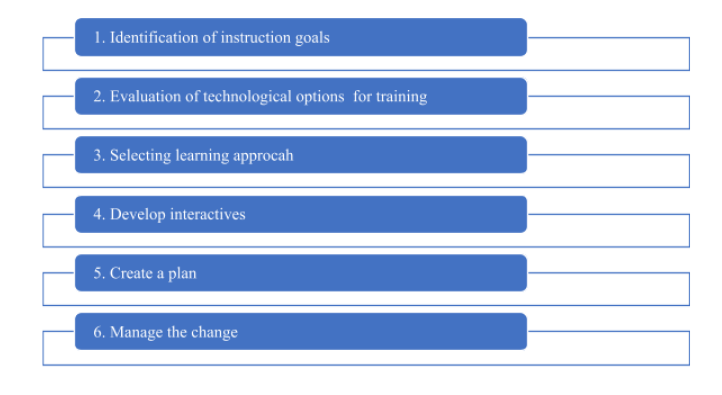
Fig 2- Steps to implement ILT in Apple Inc.
Source- (Self-Created)
2. Step 5– TNA Report
2.1 TNA Reasons and Investigative Processes
Considering the overall report from the first assessment, the investigative process has been taken into consideration wherein figure 3 illustrates the reason for conducting this process. Hence, lack of employee training, lack of collaboration amongst management and inadequate employee performance are the reasons to conduct the investigative process within the organisation. Hence, with the help of the investigative process, all these issues have been identified and analysed in order to improve employee engagement and collaboration for better organisational performance in future.
On the other hand, based on the investigative process that has been drawn on figure 3 below shows the training needs analysis for the organisation wherein ILT will eventually help to boost employee performance and provides opportunities for learning and identifying the individual weaknesses. Instructor-Led-Training will help the organisation to improve workforce planning, manages workloads and designation, improve employee morale and clear accountabilities. In addition to this, it has been found that this training method will also meet the Training Needs Analysis by boosting adherence to quality standards, improve organisational flexibility and employee satisfaction on employment.
Training Needs Analysis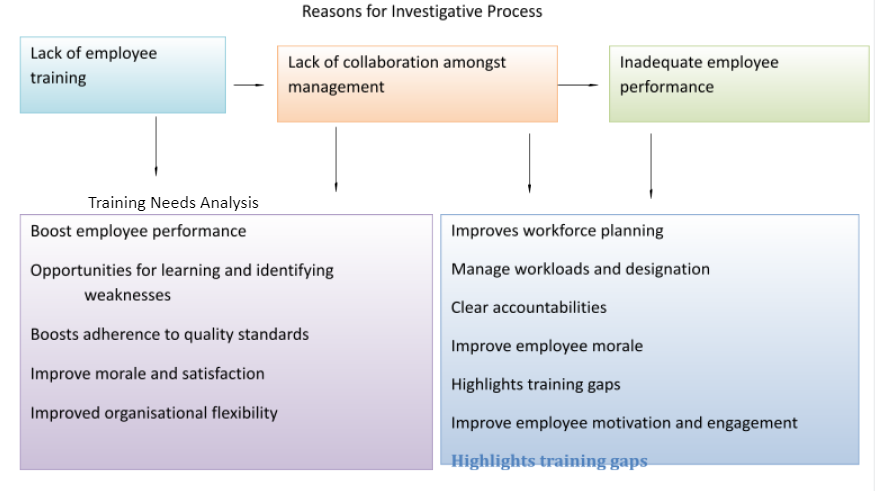
Fig 3- Reasons for investigative process and needs of training
Source- (Self-Created)
2.2 TNA Learner Population, Learning Outcomes and Learning Objectives
Learner Population
In Instructor-led Training, the learner population can comprise of the employees who are keen to learn on a regular basis about different aspects of the firm and about the skills and knowledge that is required for their job performances. The employees who are an enthusiast for a more traditional, the former version of training that occurs in a classroom in front of the leaders. In the chosen organization i.e. Apple Inc., the employees can go through this traditional form of training in order to improve their employee performance (Vaishali 2019).
Table 1: Learner Population
|
Employee Administrative Learners |
Employee Administrative Position |
Responsibility Level |
Age Range |
Operational Platform Training |
|
Learner 1 |
Project Manager |
Managerial |
35-40 |
Instructor-led training |
|
Learner 2 |
Customer Service Provider |
To provide support to prospective as well as existing customers |
40-50 |
Instructor-led training |
|
Learner 3 |
IT staff |
Managing Data security system |
26-30 |
Instructor-led training |
|
Learner 4 |
Business Development Executives |
Attracting new customers |
25-45 |
Instructor-led training |
Learning Outcomes
The learning outcomes that the employees of the chosen company can acquire with the help of instructor-led training is that they can be personalized learning, which means that the employees can tailor approaches and answer specific questions with small groups of learners. The employees will be able to deal with the business issues and any problems faced by them in the firm in the most effective way. In addition to that, the employees will be able to attain immediate feedback, which plays a vital role in their performance improvement. This will lead the employees to improve their efficiency in their tasks in a most effective way that will eventually reflect in the overall performance management of the firm. However, for filling the employee training gap identified in Apple Inc., the learning outcomes produced from the instructor-led training would be the most appropriate one (Bhardwaj, Kapil & Sharma 2019).
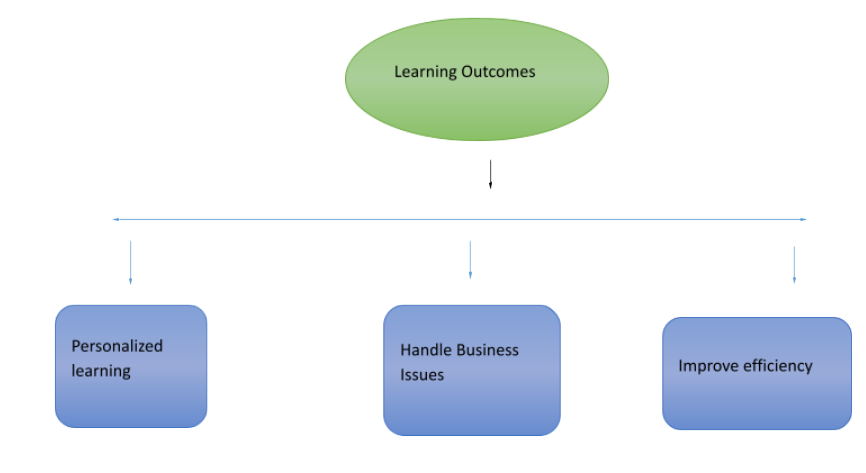
Figure 4: Learning Outcomes
Source- (Self-Created)
Learning Objectives
The learning objective of providing employee training to the employees in Apple Inc. is to offer them the knowledge related to the job so that they can achieve success in everything they do. In addition to that, the learning objectives also include communicating skills among the workers in a most systematic way so that their learning power also improves subsequently. This will enable them to be more enthusiastic in learning new skills and knowledge in order to peek up their performance in the firm. The chosen employee training method for the employees of the firm will help the employees to be motivated towards success and to achieve the same quickly. In addition to that, the firm will also be able to ensure that the employee team has one of the most significant contributions towards the growth and expansion of the firm (Vinikas 2021).

Figure 5: Learning Objectives
Source- (Self-created)
2.3 Justification of Learning Strategy and Learner Evaluation Methods
Learning Strategy
The strategies that are followed by the instructors through the specified training method are as follows:
Outlining the Objectives- The first step that is involved in the training through this method is that the instructor outlines the objectives for the trainees so that they can be specific about what they are going to learn through the training process. With these strategies, the employees become masters by the end of the training program.
Ensuring Relevance-The next strategy is to ensure relevancy as soon as the learning objectives are outlined in order to make the employees clear about why the chosen learning objectives are relevant for them in their performance and what benefits it can provide them to improve their performance.
Designing and developing the learning experience- After ensuring the relevancy, the trainer designs and develops the learning experience in order to analyze the details of the employee position in order to make sure that the ultimate learning outcome can benefit them in all possible ways.
Creation of Plan- The final strategy for initiating the training is to create a plan wherein the trainees will have a good idea about what the training is supposed to cover and how it be delivered (Neendoor 2020).
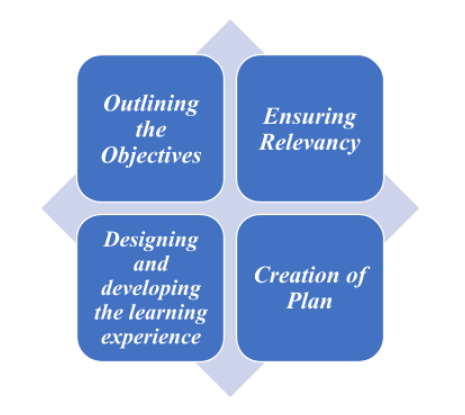
Figure 6: Learning Strategies
Source- (Self-Created)
Learning Evaluation method
The learning evaluation is done through instructor-led training in the following ways:
Reaction- It is the first level of evaluation of the learning of the employees wherein the trainers analyze the way the employees react to the training given to them. In order to identify the overall reactions, the trainees will be asked to complete a short survey or feedback forms.
Learning- It is the second stage, wherein the trainers tend to acknowledge what the employees have actually learned from the training provided to them. In order to do so, the trainer conducts some practical tests or short quizzes before as well as after the training.
Behaviour- In this stage, the trainer assesses whether the employees actually put this knowledge and skills into practice while performing in the firm. In order to do so, the trainer asks the employees to complete self-assessments.
Results- This is the last stage wherein the employees are assessed regarding their efficiency in their performance after providing them with adequate training and to make sure that their performance levels have been meeting the expectations of the stakeholders.
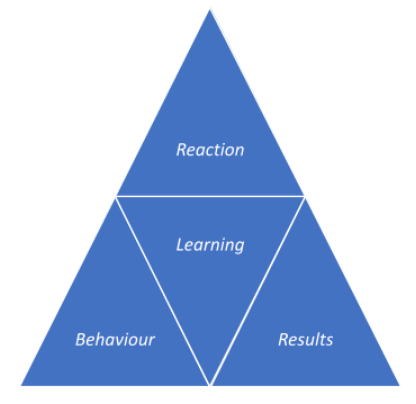
Figure 7: Learning Evaluation
Source: (Self-Created)
3. Step 6– Design and Implementation of Learning Program
3.1 Learning Program design: Instructional System Design
For the learning program design under ILT, Instructional system design has been taken into consideration wherein it provides a formal approach to training where the objectives of the training are carefully determined often from several types of learners' assessments. In addition to this gaols are established to overcome the outcomes of the assessments, several methods of training and learned need to be developed within the employee (Hess 2016). The selected design includes a systematic process for the evaluation and development of training solutions, planned mainly for the purpose of formal training delivery. It has been identified that there are two comprehensively identified instructional design models in practice at a current stage wherein both educational corporate and organisations training functions. The conventional is the ADDIE Model and this model has several variations; on the other hand the second is the agile model, wherein there are several variations that include rapid application development, the rapid development of content and the model of successive approximation (Manjale 2014).
3.1 ADDIE Model
ADDIE Model has been taken into considerations in order to design and implement the learning design in Apple Inc. Hence, the selected model focuses on five stages and they are as follows:
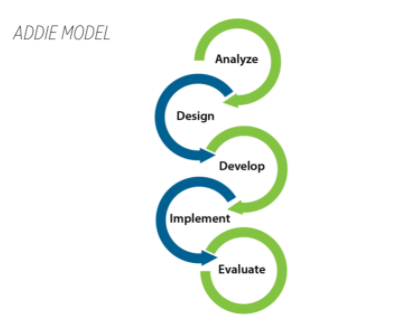
Fig 8- ADDIE Model
Source- (Taçg?n & Güner 2014)
Analyse- The primary phase of the ISD model is said to be the analysis phase and the objective of the instructional analyst is to evaluate the overall circumstances and decide if there is a need for training for employees (Kapur 2018). In certain cases, the analyst decides that a training need exists then an aim of what work responsibilities need training and the methods wherein these programs are sufficiently organised need to be taken into considerations. The tasks needing training are recorded in the list of training tasks wherein it is practised as a foundation for training gaols that will generally be presented in the learning process.
Design- In this phase, the organisational management needs to use the list of training tasks as the underpinning for the various design activities development such as the learning objectives development and related items for the test. As per ADDIE Model, in order to train the employee, classroom instruction needs to be effective and the trainer should make sure that the level and sphere complexity of the learning objectives associate with the items of test and the tasks require to be involved in the list that needs training (Jackson 2019). However, this phase addresses several concerns to attain optimal systematic development and these factors involve learning content objectives, evaluation instruments, analysis of the subject matter, planning lessons and media.
Develop- The training experts will make the content following the blueprint design phase that involves graphics and storyboards along with the e-learning technologies integration. In this case, the specialists of instructional systems change roles from conducting an evaluation to developing the real programme.
Implement- This stage in the ISD model reflects on developing for training both the learners and facilitators. Facilitator training must articulate the learning outcomes, the curriculum, and the method of testing and delivery procedures. Employee preparation involves training them on the practice of new hardware and software and the steps to register (Linh & Suppasetseree 2016). In addition to this, training professional creates the test and learning materials and e-learning.
Evaluate- The stage of evaluation is ongoing throughout the process of design and its aims are to make sure that all goals of learning will meet the particular needs of the business. The training experts also recognise the goals of performance and makes sure that the needs of business performance are met.
3.1 Formal and Systematic Training
Formal training is a designed form of training that has an intended, consistent training approach that helps the trainee to gain knowledge in the most systematic matter. However, the formal and systematic training involves a careful assessment and attention to determining training gaols, designing and building methods and materials that are directly aligned to accomplish the goals along with the implementation of training and careful evaluation to make sure that the ultimate goals of the formal training are accomplished.
As per most of the research, the systematic approach of the training process makes sure that the training starts and finishes with the needs and requirements of the company. This process tends to provide training in the most systematic way as it enables the firm to equip the employees with the knowledge and resources in order to accomplish the ultimate goals of the firm. The systematic approach to training has various significances in the business organization, which are as follows:
Higher Productivity- Formal and systematic training enables an increment in the skills, ability, and capabilities of workers that leads to an increment in the overall productivity level. This is because systematic training helps the employees to be a perfectionist in their task with which they can perform their task with extra effort and efficiency that helps them to achieve the organizational goal in the most effective way (Krishali 2019).
Job Satisfaction- One of the major importance of formal and systematic training is that it enables the employee to gain a higher level of job satisfaction. This is because the training provided with a systematic approach enables the employees to meet the entire requirements of each task that is allocated to them. It also helps the trainees to make sure that they are satisfied in their job aiding them to achieve the standards of their performance (Almoayad, Fiala, and Kofi, 2021).
4. Step 7– Evaluation of Learning Program
The process of evaluating the progress of the employees is the important part of training in order to make sure that the effectiveness of the employee has been having a great impact on the trainee. This evaluation process will help the employee to improve their effectiveness in the most significant way. Therefore, the chosen evaluation metrics for assessing the impact of training effectiveness of the instructor-led training process are as follows:
4.1 Learning Metrics: Progress & Completion Rates
Progress and completion rates refer to the metrics, which is the starting point in assessing the effectiveness of the training provided to the employees. With these metrics, the trainer will be able to keep track of the employee's progress regarding how often and how successfully the learner can study the content. Basically, these metrics help the trainer to evaluate the ability of the learner in exploring their knowledge and skills. This also helps the trainee to provide accurate and correct feedback to the employee in order to make sure that the learner can actually use the knowledge and skill provided through the training process throughout their career (Colman 2019).
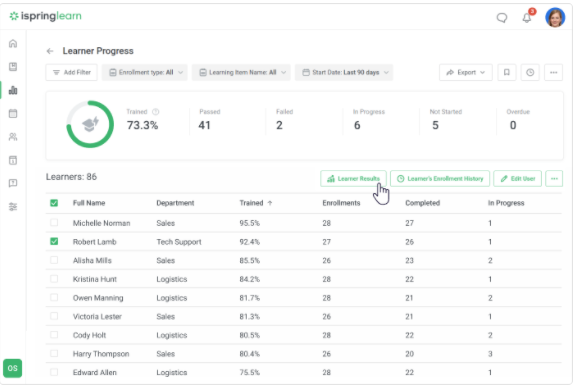
Figure 9: Progress & Completion Rates
Source: (Colman 2019)
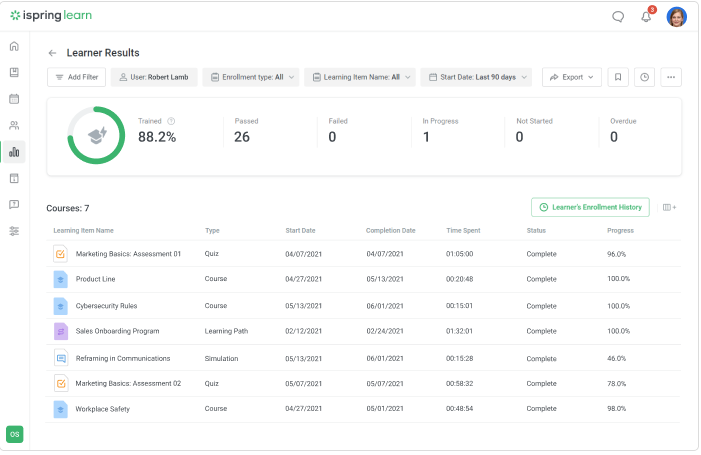
Figure 10: Progress & Completion Rates
Source: (Colman 2019)
As per the given tables, it can be said that the progress of the employees or learners can be tracked in the learner's progress folder on a regular basis so that the overall progress at the end of the training can be assessed in an accurate way. This enables the trainer to focus on each learner individually and train them as per their respective progress rate (Zhou et al. 2021).
4.2 The Learning-Transfer Evaluation Model (LTEM)
In order to evaluate the chosen training method i.e., Instructor-Led Training, the LTE Model has been taken into considerations. This model has been proposed by Dr Will Thalheimer, who is said to be an instructional consultant and designer and focused on the multitiered evaluation of the training model (Richter 2019). It combines the learning process on the other. The selected model emphasises on the various procedures of learning and putting it into action in the adopted environment. Thus, it has eight tiers articulating broad understanding and learning; and ultimately the top tiers discussing where learning changes into complete integration and application on the employment. Hence, this model helps to evaluate learning and makes a trick that shows several conducts wherein applicants employ with its entire process. For example, if an employee engages in activities, it can often think that they have thus learned. However, training does not show the same knowledge and most of what the organisational management have consideration of wisdom is not learning as a whole.
However, the model is created to be appropriate for all learning interventions, including self-learning, classroom learning, as well as e-learning, etch wherein learning occurs and the management evaluate it. Thus, the organisational management has to change the old evaluation practice and use this model to help bring wisdom to their efforts. Thus, as per the 8 tier of LTEM focuses on learners are frequently assessed based on employee attendance, part-taking in activities, and their own perspectives of knowledge. Certainly, these can be focused as initiating points other than they do not even start to obtain at what wisdom should be included while training.
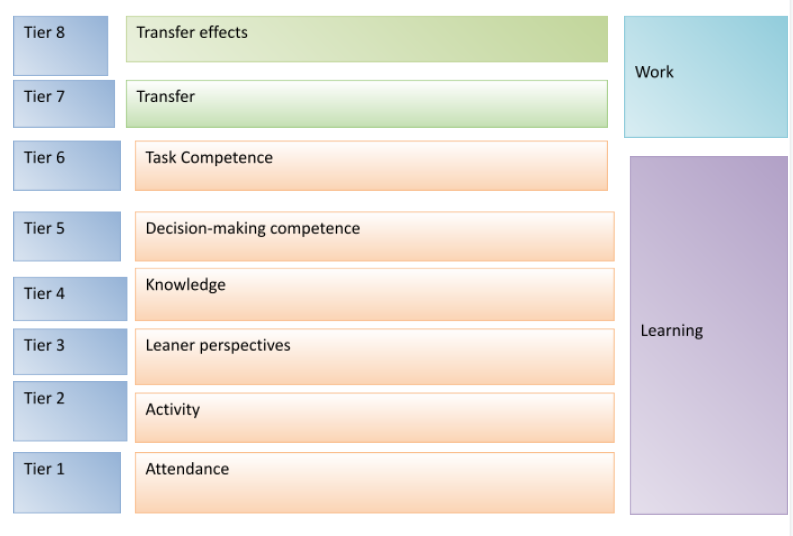
Fig 11- Eight Tier of LTE Model
Source- (Self-Created)
Moreover, it can be said that the overall tier focuses on the evaluation of employee training that has been conducted with the help of Instructor-Led-Training and with the Instructional Design System. Here, the first tier reflects on participating for training, the second tier shows interest, attention and participation, the third tier shows motivation adopted for the entire employee training, the fourth tier signifies terminology of understanding through training, the fifth tier focuses on executing knowledge in realistic scenarios, the sixth tier articulates proper actions in certain scenarios and the ultimate tier reflects on evaluating the impact of transfer knowledge.
5. Conclusion
The overall assignment is based on the issues that have been identified through the firm assessment i.e. lack of training provided to the employee that has led to improper employee performance in Apple Inc. However, the chosen training to provide to the employees for improving the employee performance in the organization is Instructor-led learning. The assignment covers three steps such as TNA report, Design, and implementation of the Learning Program, and Evaluation of the Learning Program. In the first step, the assignment illustrates the reasons for the investigative process. In addition to that, the discussion has also included the learning population, outcomes, and objectives of training through the specified training method. In the second step, the assignment has highlighted the ADDIE model and Instructional System Design, which is a formal approach to employee training.
Furthermore, the assignment has also highlighted the evaluation process for which the evaluation metrics have been chosen as LMS metrics: Progress & Completion rate, wherein the overall progress of the employee is tracked on a regular basis and evaluated accordingly. It has been identified that these metrics enable the evaluation of the progress of each learner with which the training can be provided to them accordingly. Another metric used for the evaluation is The Learning-Transfer Evaluation Model (LTEM) with which the trainer can ensure that learning outcomes of the training can effectively be put into action by the learner throughout their job performance. As a whole, it can be concluded that the overall assignment has been done with the consideration of a proper employee training method that can be provided to the employees.
References
Almoayad, F., Fiala, L. & Kofi, M., 2021. [online] Available at:
Bhardwaj, A, Kapil, D & Sharma 2019, ‘EMPLOYEE TRAINING AND DEVELOPMENT THROUGH E-LEARNING’ (A STUDY OF SOME SELECTED UNITS IN POWER SECTOR) To the UNIVERSITY OF KOTA, viewed 1 October 2021,
Colman, H 2019, Employee Training Metrics: How to Measure eLearning Effectiveness, Your Digital Learning Expert, viewed 2 October 2021,
Hess, N 2016, ‘Greer Designing for Engagement’, COMMUNICATIONS IN INFORMATION LITERACY |, vol. 10, no. 2, viewed 1 October 2021,
Jackson, B 2019, Instructor-Led Training: Creating an Effective Learning Experience, Mindtools.com, viewed 1 October 2021,
Kapur, R 2018, Designing and Implementation of Training Programs in Organizations, ResearchGate, viewed 1 October 2021,
Krishali 2019, Advantages of Training Employees, Economics Discussion, viewed 1 October 2021,
Linh, ND & Suppasetseree, S 2016, ‘The Development of an Instructional Design Model on Facebook Based Collaborative Learning to Enhance EFL Students’ Writing Skills’, IAFOR performance management assignment Journal of Language Learning, vol. 2, no. 1.
Manjale, B 2014, Application of ADDIE Model of Instruction in Teaching-Learning Transaction among Teachers of Mara Conference Adventist Secondary Schools, Tanzania, viewed 1 October 2021,
Neendoor, S 2020, Training Evaluation - 5 Best Ways to Evaluate Training Effectiveness and Impact, Kitaboo, viewed 1 October 2021,
Panopto 2017, Corporate Training Trends: Instructor-Led Training Going Virtual, Panopto Video Platform, viewed 1 October 2021,
Richter, MS 2019, Seven Applications for Thalheimer’s LTEM (Learning-Transfer Evaluation Model), The Thiagi Group, viewed 2 October 2021,
Taçg?n, Z & Güner, NE 2014, ‘ADDIE Model in Adult Education: Instructional Design Sample of E-Learning’.
Vaishali 2019, Objectives of Employee Training, Economics Discussion, viewed 1 October 2021,
Vinikas, I 2021, 5 Reasons Why Learning and Development Is So Important for Organizations In 2021, Kaltura, viewed 1 October 2021,
Zhou, J, Gandomi, AH, Chen, F & Holzinger, A 2021, ‘Evaluating the Quality of Machine Learning Explanations: A Survey on Methods and Metrics’, Electronics, vol. 10, no. 5, p. 593, viewed 2 October 2021,












